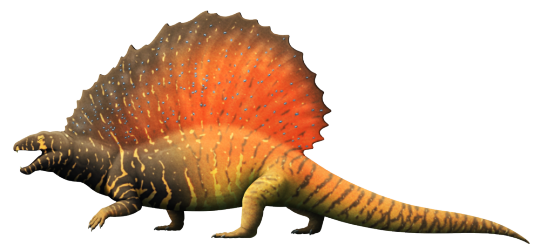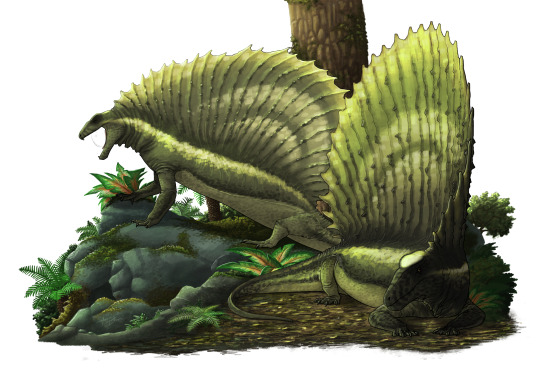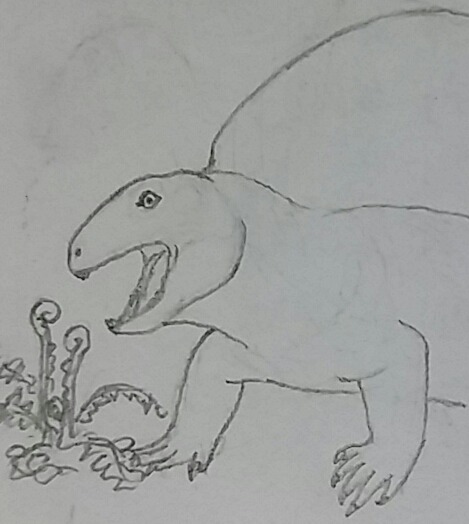#gordodon
Photo

Some of the earliest large terrestrial herbivores on Earth were the edaphosaurids – a very early-branching group of synapsids, the evolutionary lineage whose only modern surviving members are mammals. Like their more famous cousin Dimetrodon these animals sported huge elaborate sails on their backs formed from highly elongated vertebral spines, but despite the similarity in appearance they actually seem to have evolved these structures completely independently.
Known from a single partial skeleton discovered in southern New Mexico, USA, the edaphosaurid Gordodon kraineri dates to around the very end of the Carboniferous or the very earliest Permian, about 299 million years ago.
It was fairly small for an edaphosaurid at about 1.5m long (~5'), and seems to have had transitional anatomy between earlier and later members of the group. Its sail spines were thicker than those of earlier species but still less heavyset than those of later forms, and while each spine had numerous side projections these structures were small, thorn-like, and randomly distributed, unlike the more organized thick crossbars seen in Edaphosaurus.
Its head was proportionally small compared to its body, but still relatively large for an edaphosaurid, and it had an unusually long neck for an early synapsid. But its most distinctive features were its jaws and teeth – it had a narrow snout with a pair of large incisor-like teeth at the front of both its upper and lower jaws, followed by a large toothless gap (a diastema) and then a short row of small peg-like teeth. Like Edaphosaurus it also would have had batteries of grinding tooth plates inside its upper and lower jaws, but probably not as extensively.
Overall its tooth arrangment looked more like a modern herbivorous mammal than an early synapsid, much more highly specialized than anything else known to be alive at the time – the next synapsid known to convergently evolve similar teeth lived around 90 million years later!
It probably had a very different diet to its relatives, with its specialized teeth and fairly slender body suggesting it may have been a selective feeder, cropping the softer more nutritious parts of plants like the fleshy seeds and cones of gymnosperm plants.
Its discovery also hints that herbivorous edaphosaurids in general were much more diverse than we previously thought, and there may be even more surprising forms out there still to be discovered.
———
Nix Illustration | Tumblr | Twitter | Patreon
#science illustration#paleontology#paleoart#palaeoblr#gordodon#edaphosauridae#eupelycosauria#synapsid#stem-mammal#art#this is the counterpart to lutrinization in synapsid evolution#Make Rodent Teeth#because it just. keeps. happening.
424 notes
·
View notes
Photo

Gordodon kraineri
This is the first in a bunch of palaeoartworks I’m producing for @wtf-permian, in preparation for this year’s Permian March Madness! I’ll post these as I draw them up to the start of Permian March Madness to bring y’all up to speed with some of our contestants!
First up, Gordodon! A close relative of the more famous Edaphosaurus, Gordodon is one of the earliest examples of land vertebrates beginning to specialise into different dietary niches! In the Carboniferous period, land vertebrates were mostly small omnivores, but in the Permian they started to diversify into all kinda of absolutely wild forms.
Gordodon was once of these, with a rather buck-toothed set of jaws that might have been used for nipping off bits of vegetation! It’s also one of the earlier examples of sail-backed pelycosaurs, a group that would go on to produce Dimetrodon, which will not be making an appearance in Permian March Madness because it’d probably win on star power alone and that’s not what we’re about!
So, that’s Gordodon! Stay tuned for more, and don’t forget to follow @wtf-permian for when Permian March Madness gets going!
#gordodon#palaeoart#paleoart#palaeontology#paleontology#palaeoblr#wtf-permian#permian march madness#synapsid#pelycosaur#not a dinosaur
294 notes
·
View notes
Text

Gordodon Ramsey upset at fern menu.
8 notes
·
View notes
Text
Descubren un fósil de reptil de 300 millones de años parecido a los humanos
Descubren un fósil de reptil de 300 millones de años parecido a los humanos
El descubrimiento de este fósil ha obligado a la comunidad científica a reescribir parte de la historia de la vida en la tierra debido a que vivió muchos años antes que los antiguos dinosaurios y comía frutas y plantas.
Según lo han informado en un comunicado las autoridades del Museo de Historia Natural y Ciencia de Nuevo México (NMMNHS), investigadores de la Universidad de Oklahoma, han…
View On WordPress
0 notes
Text
Descubren en EE. UU el fósil de reptil herbívoro más antiguo y da indicios sobre evolución
Descubren en EE. UU el fósil de reptil herbívoro más antiguo y da indicios sobre evolución
Gordodon vivió en el Periodo Pérmico, unos 50 millones de años antes de que sugieran los dinosaurios.
El hallazgo en Nuevo México (EE.UU.) del fósil de un reptil herbívoro de unos 300 millones de años, y señalado como el fósil más antiguo de un reptil herbívoro, obliga a “reescribir” la evolución de esta clase de animales, según dijeron a Efe investigadores del descubrimiento.
“Tendremos que…
View On WordPress
#Ciencia#Concepto del Proyecto#ecolución#EE.UU.#EFE#fósil#Gordodon#herbívoro#Noticias#reptil#Ser científico
0 notes